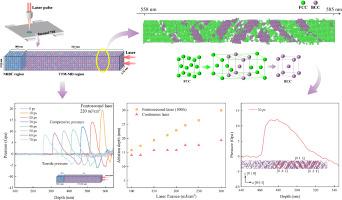Molecular dynamics investigation of femtosecond laser ablation of Inconel 718 alloy
IF 6.1
1区 工程技术
Q1 ENGINEERING, MANUFACTURING
引用次数: 0
Abstract
In this work, the expansion, spallation, pressure wave propagation, and structural evolution during femtosecond laser ablation of Inconel 718 alloy were investigated using molecular dynamics simulation. The results found that femtosecond laser ablation achieves deeper energy penetration than continuous laser, facilitating finer processing. Under the irradiation of femtosecond laser, the crystal structures of the target are gradually transformed from a long-range ordered structure to an amorphous structure, accompanied by the generation of stacking faults composed of BCC crystal structures. In addition, the effect of laser parameters is also examined. It is found that the expansion of the heat affected region with increasing laser fluences is one of the reasons for inducing compressive pressure generation. The transmission of the pressure wave is independent of the pulse durations, but the surface temperature rise of the target is closely related to the pulse durations. As pulse durations decrease, the surface ablation becomes more intense, which can be attributed to a higher temperature rise at the surface of the target rather than a greater tensile pressure. Thus, femtosecond laser ablation effect is caused by the combined impact of pressure wave and temperature. This work lays a theoretical foundation for exploring the dynamic thermodynamic mechanism phenomena and crystal structures evolution of high temperature alloy materials processed by femtosecond laser.

飞秒激光烧蚀 Inconel 718 合金的分子动力学研究
本研究利用分子动力学模拟研究了飞秒激光烧蚀 Inconel 718 合金过程中的膨胀、剥落、压力波传播和结构演变。结果发现,与连续激光相比,飞秒激光烧蚀实现了更深的能量穿透,有利于更精细的加工。在飞秒激光的辐照下,靶材的晶体结构由长程有序结构逐渐转变为非晶态结构,并伴随着由 BCC 晶体结构组成的堆积断层的产生。此外,还研究了激光参数的影响。研究发现,热影响区随着激光通量的增加而扩大,这是诱导压缩压力产生的原因之一。压力波的传输与脉冲持续时间无关,但目标的表面温升与脉冲持续时间密切相关。随着脉冲持续时间的缩短,表面烧蚀会变得更加强烈,这可能是由于目标表面的温升较高,而不是由于拉伸压力较大。因此,飞秒激光烧蚀效应是由压力波和温度的共同影响造成的。这项工作为探索飞秒激光加工高温合金材料的动态热力学机理现象和晶体结构演化奠定了理论基础。
本文章由计算机程序翻译,如有差异,请以英文原文为准。
求助全文
约1分钟内获得全文
求助全文
来源期刊

Journal of Manufacturing Processes
ENGINEERING, MANUFACTURING-
CiteScore
10.20
自引率
11.30%
发文量
833
审稿时长
50 days
期刊介绍:
The aim of the Journal of Manufacturing Processes (JMP) is to exchange current and future directions of manufacturing processes research, development and implementation, and to publish archival scholarly literature with a view to advancing state-of-the-art manufacturing processes and encouraging innovation for developing new and efficient processes. The journal will also publish from other research communities for rapid communication of innovative new concepts. Special-topic issues on emerging technologies and invited papers will also be published.
 求助内容:
求助内容: 应助结果提醒方式:
应助结果提醒方式:


